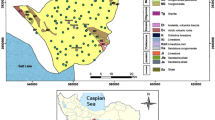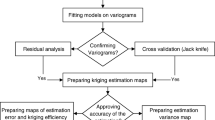Abstract
This paper highlights the advantages of multivariate statistical and geostatistical methods to compile the hydro-geochemical properties of groundwater. A total of 123 samples were collected from wells located in Saveh aquifer, in 2015. Seven parameters including total dissolved solids (TDS), sodium adsorption ratio( SAR), electrical conductivity (EC), sodium (Na+), total hardness (TH), chloride (Cl−), and sulfate (SO42−) were analyzed, compiled, and interpreted statistically and geostatistically. At first, factor analysis gave rise to produce a factor representing 94% of the variability. Also, variography was calculated and compiled to define spatial regression and experimental variograms were plotted by GS+ software, then, the best theoretical models were fitted on the variograms and an estimation map was prepared based on geostatistical relationship presented in the paper. Smoothing effect is one of the main drawbacks of forward geostatistical methods, on the contrary, inversed methods are subjected to no smoothing effect. Results showed that geostatistical inversed methods could reveal more reliable results than forward methods. Eventually, the map of the estimated factor, as well as error maps, was compiled. According to the evaluation of fractal dimensions, the estimated factor explained the variability of all hydrogeochemical parameters and groundwater quality was categorized as the safe, normal, and anomalous class, ranged from − 1.10 to 1.10, 1.11 to 3.1, and more than 3.1, respectively.












Similar content being viewed by others
References
Adhikary, P. P., Dash, C. J., Chandrasekharan, H., Rajput, T. B. S., & Dubey, S. K. (2012). Evaluation of groundwater quality for irrigation and drinking using GIS and geostatistics in a peri-urban area of Delhi, India. Arabian Journal of Geosciences, 5(6), 1423–1434.
Barca, E., & Passarella, G. (2008). Spatial evaluation of the risk of groundwater quality degradation, a comparison between disjunctive kriging and geostatistical simulation. Journal of Environmental Monitoring and Assessment, 137(1), 261–273.
Barca, E., Porcu, E., Bruno, D., & Passarella, G. (2017). An automated decision support system for aided assessment of variogram models. Journal of Environmental Modelling and Software, 87, 72–83.
Bartlett, M. S. (1947). Multivariate analysis. Supplement to the Journal of the Royal Statistical Society, 9(2), 176–197.
Boyacioglu, H., & Boyacioglu, H. (2007). Water pollution sources assessment by multivariate statistical methods in the Tahtali basin, Turkey. Journal of Environmental Geology, 54(2), 275–282.
Chilès, J. P., & Delfiner, P. (2012). Geostatistics: modeling spatial uncertainty (p. 731). Wiley.
Deutsch, C. V., & Journel, A. G. (1998). GSLIB: geostatistical software library and user’s guide (2nd ed.p. 369). New York: Oxford University Press.
Draper, N. R., & Smith, H. (1998). Applied regression analysis (3rd ed.). Wiley ISBN 0-471-17082-8.
Dungan, J.L.A., van der Meer, F., & Gorte, B (Eds.) (1999). Conditional simulation. In Stein spatial statistics for remote sensing (pp. 135–152). Stein: Dordrecht, Kluwer Academic Publishers.
Edition, F. (2011). Guidelines for drinking-water quality. WHO Chronicle, 38, 104–108.
Fakharian, K., & Narany, T. S. (2016). Multidisciplinary approach to evaluate groundwater salinity in Saveh plain, Iran. Journal of Environmental Earth Sciences, 75(7), 1–11.
Howarth, R. J., & Earle, S. A. M. (1979). Application of a generalized power transformation to geochemical data. Journal of the International Association for Mathematical Geology, 11(1), 45–62.
Jalali, M., Karami, S., & Marj, A. F. (2016). Geostatistical evaluation of spatial variation related to groundwater quality database: case study for Arak plain aquifer, Iran. Journal of Environmental Modeling and Assessment, 21(6), 707–719.
Jolly, W. M., Graham, J. M., Michaelis, A., Nemani, R., & Running, S. W. (2005). A flexible, integrated system for generating meteorological surfaces derived from point sources across multiple geographic scales. Journal of Environmental Modelling and Software, 20(7), 873–882.
Journel, A.G. (1989). In: Fundamentals of geostatistics in five lessons, short course in geology. American Geophysical Union, 8, 10 p.
Journel, A. G., & Huijbregts, C. J. (1978). Mining geostatistics. Orlando: Academic Press, New York 600 p.
Kaiser HF (1974) An index of factorial simplicity. Psychomet, 39, 31–36.
Karami, S., Madani, H., Katibeh, H., & Fatehi Marj, A. (2018). Assessment and modeling of the groundwater hydrogeochemical quality parameters via geostatistical approaches. Applied Water Science, 8(1), 23.
Kevin, J., Jay, M., Ver, H., Krivoruchko, K., & Neil, L. (2003). Using ArcGIS geostatistical analyst, (ESRI Userbook) (p. 308). USA: Environmental System Research Institute.
Krige, D. G. (1996). A practical analysis of the effects of spatial structure and of data available and accessed, on conditional biases in ordinary kriging. Journal of Geostatistics Wollongong, 96, 799–810.
Kumar, P. J. S., Jegathambal, P., & James, E. J. (2011). Multivariate and geostatistical analysis of groundwater quality in Palar river basin. International Journal of Geology, 5(4), 108–119.
Lane, D.M. (2007). HyperStat online statistics textbook: null hypothesis (1 of 4).
Lewis-Beck, M. S. (1994). Factor analysis and related techniques. Jurong, Singapore: Sage Inc.
Lin, Y. P. (2002). Multivariate geostatistical methods to identify and map spatial variations of soil heavy metals. Journal of Environmental Geology, 42(1), 1–10.
Lin, Y. P., Tan, Y. C., & Rouhani, S. (2001). Identifying spatial characteristics of transmissivity using simulated annealing and kriging methods. Journal of Environmental Geology, 41(1–2), 200–208.
Mahlknecht, J., Steinich, B., & Navarro de León, I. (2004). Groundwater chemistry and mass transfers in the Independence aquifer, central Mexico, by using multivariate statistics and mass-balance models. Environmental Geology, 45(6), 781–795.
Manish, K., Ramanathan, A., Rao, M. S., & Kumar, B. (2006). Identification and evaluation of hydro-geochemical processes in the groundwater environment of Delhi, India. Journal of Environmental Geology, 50(7), 1025–1039.
Martin, J. A. R., Arias, M. L., & Corbı, J. M. G. (2006). Heavy metals contents in agricultural topsoils in the Ebro basin (Spain). Application of the multivariate geoestatistical methods to study spatial variations. Journal of Environment and Pollution, 144(3), 1001–1012.
Masciale, R., Barca, E., & Passarella, G. (2011). A methodology for rapid assessment of the environmental status of the shallow aquifer of “Tavoliere di Puglia” (Southern Italy). Journal of Environmental Monitoring and Assessment, 177(1), 245–261.
Matalas, C. N., & Reiher, J. B. (1967). Some comments on the use of factor analysis. Journal of Water Research, 3(1), 213–223.
Mckinley, J. M., Atkinson, P. M., Lloyd, C. D., Ruffell, A. H., & Worden, R. H. (2011). How porosity and permeability vary spatially with grain size, sorting, cement volume and mineral dissolution in fluvial Triassic sandstones: the value of geostatistics and local regression. Journal of Sedimentary Research, 81(12), 844–858.
Mehrjardi, R. T., Jahromi, M. Z., Mahmodi, S., & Heidari, A. (2008). Spatial distribution of groundwater quality with geostatistics (case study: Yazd-Ardakan plain). World Applied Sciences Journal, 4(1), 9–17.
Muangthong, S., & Shrestha, S. (2015). Assessment of surface water quality using multivariate statistical techniques: case study of the Nampong River and Songkhram River, Thailand. Journal of Environmental Monitoring and Assessment, 187(9), 1–12.
Nas, B. (2009). Geostatistical approach to assessment of spatial distribution of groundwater quality. Polish Journal of Environmental Studies, 18(6), 1073–1082.
Rossi, M. E., & Deutsch, C. V. (2014). Mineral resource estimation (p. 337). Science and Business Media.
Sadat-Noori, S. M., Ebrahimi, K., & Liaghat, A. M. (2014). Groundwater quality assessment using the water quality index and GIS in Saveh-Nobaran aquifer, Iran. Journal of Environmental Earth Sciences, 71(9), 3827–3843.
Sarah, S., Jeelani, G., & Ahmed, S. (2011). Assessing variability of water quality in a groundwater-fed perennial lake of Kashmir Himalayas using linear geostatistics. Journal of Earth System Science, 120(3), 399–411.
Schlotzhauer, S. D. (2007). Elementary statistics using JMP. SAS Institute.
Sheikhi Narani, T., Najari, M., Fakharian, K., & Sultan Mohammadlou, A. (2010). Zoning of Saveh plain aquifer groundwater quality and its correlation with geological formations. 4th International Conference on Geotechnical Engineering and Soil Mechanics (ICGESM 2010), Iranian Geotechnical Society, Tehran, 2–3 November 2010. Available at: http://www.civilica.com/Paper-ICGESM04-ICGESM04_336.html.
Snowden, D.V., & Edwards, A.C. (2001). Practical interpretation of mineral resource and ore reserve classification guidelines. Mineral Resource and Ore Reserve Estimation-The AusIMM Guide to Good Practice, 643–652.
Zhou, F., Liu, Y., & Guo, H. C. (2007). Application of multivariate statistical methods to the water quality assessment of the watercourses in the northwestern new territories, Hong Kong. Journal of Environmental Monitoring and Assessment, 132(1), 1–13.
Acknowledgments
The authors would like to thank Iran Water Resources Management Company for collecting, analyzing, and providing the data. Also, we fully appreciate the anonymous reviewers for their professional reviewing which their precious comments have definitely improved the scientific quality of the paper. Hereby, we thank the editorial board of Journal of Environmental Monitoring and Assessment for their consideration.
Author information
Authors and Affiliations
Corresponding author
Additional information
Publisher’s note
Springer Nature remains neutral with regard to jurisdictional claims in published maps and institutional affiliations.
This article is part of the Topical Collection on Geospatial Technology in Environmental Health Applications.
Rights and permissions
About this article
Cite this article
Jalali, M., Karami, S. & Fatehi Marj, A. On the problem of the spatial distribution delineation of the groundwater quality indicators via multivariate statistical and geostatistical approaches. Environ Monit Assess 191 (Suppl 2), 323 (2019). https://doi.org/10.1007/s10661-019-7432-1
Received:
Accepted:
Published:
DOI: https://doi.org/10.1007/s10661-019-7432-1




